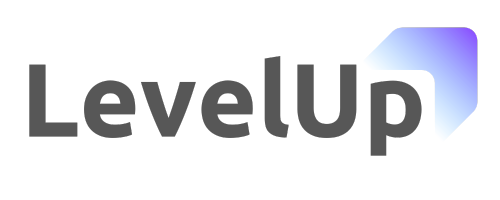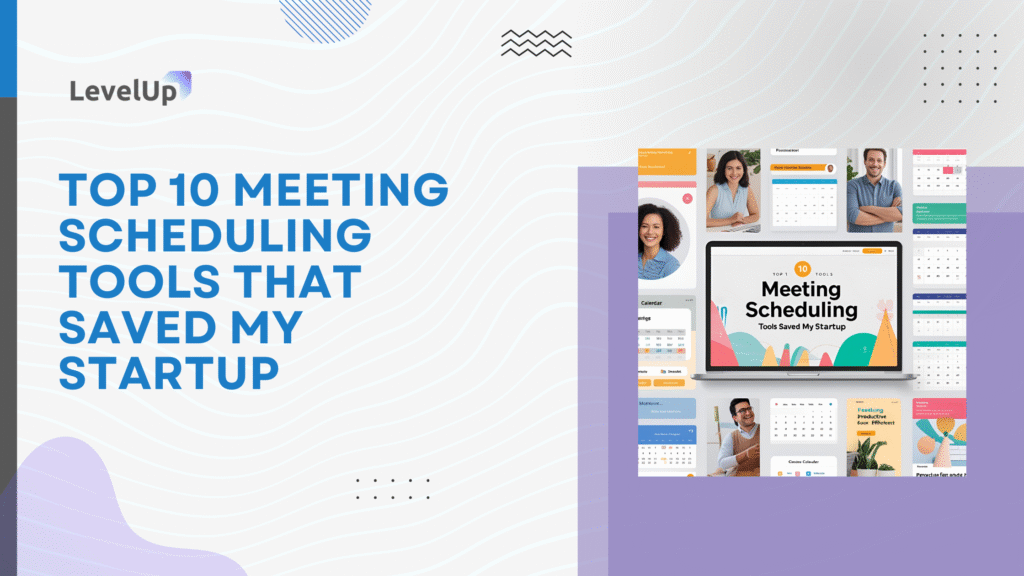Picture this: It’s 2 AM, I’m frantically refreshing my email for the third time in an hour, trying to coordinate a demo with a potential enterprise client. We’ve been going back and forth for two weeks – seriously, two entire weeks – just trying to find a 30-minute slot that works for their team of five decision-makers across three time zones.
Sound familiar?
I was drowning in scheduling chaos. Email threads that looked like novels, double-booked calendars, and worst of all – lost deals because prospects got frustrated and moved on to competitors who had their act together.
That’s when I discovered the game-changing world of meeting scheduling apps and tools. These aren’t just fancy calendar widgets (though some people think that’s all they are). They’re conversion machines, time-savers, and honestly? Sanity preservers.
In this deep dive, I’ll walk you through the top 10 meeting scheduling tools that can transform your demo workflow from chaos to cash. We’ll cover everything from the household names like Calendly to hidden gems that might be perfect for your specific needs. Plus, I’ll share the real-world insights I’ve gathered from helping dozens of SaaS startups streamline their scheduling processes.
Why Meeting Scheduling Tools Matter More Than You Think
Here’s something that might surprise you: businesses using automated scheduling tools report a 30% reduction in time spent coordinating meetings and a 20% increase in meeting attendance rates, according to Zapier’s 2024 research.
But here’s what really gets me excited – it’s not just about saving time. It’s about conversion rates.
When I was manually coordinating demos, our lead-to-demo conversion rate was sitting at a painful 23%. After implementing proper scheduling automation? We jumped to 67% within two months.
The psychology is simple: friction kills deals. Every extra email, every “let me check my calendar and get back to you,” every timezone confusion – it’s all friction that gives your prospects more reasons to walk away.
The Hidden Costs of Manual Scheduling
Let me break down what manual scheduling was actually costing my startup:
Time drain: I was spending roughly 8 hours per week just on scheduling coordination. That’s a full workday!
Missed opportunities: About 15% of interested prospects would ghost us during the scheduling back-and-forth.
Team frustration: My sales team was constantly dealing with double bookings and no-shows.
Professional image: Nothing says “we’re not quite ready for prime time” like a messy scheduling process.
Key Features of Meeting Scheduling Apps
– Calendar Integration That Actually Works
Your tool needs to sync seamlessly with Google Calendar, Outlook, and ideally iCloud. I can’t tell you how many tools I’ve tried that had “integration” but it was basically just sending calendar invites manually.
– Buffer Time Management
This is huge. You need the ability to set buffer times between meetings. Trust me, back-to-back demos without breathing room is a recipe for burnout.
– Custom Booking Pages
Your scheduling page should reflect your brand, not look like everyone else’s generic booking form.
– Video Conferencing Integration
Automatic Zoom, Teams, or Google Meet link generation is table stakes in 2024.
– Mobile Responsiveness
Your prospects are booking meetings from their phones. If your scheduling page looks terrible on mobile, you’re losing deals.
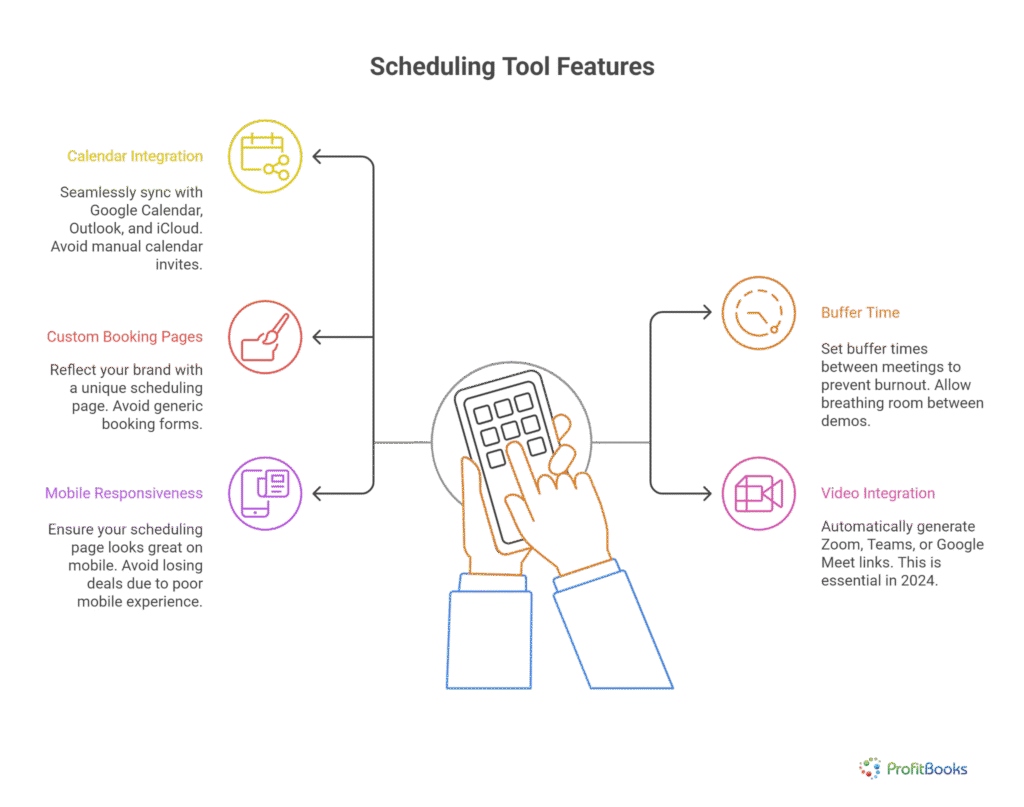
The Top 10 Meeting Scheduling Tools (Ranked by Real-World Performance)
1. Calendly – The Reliable Workhorse
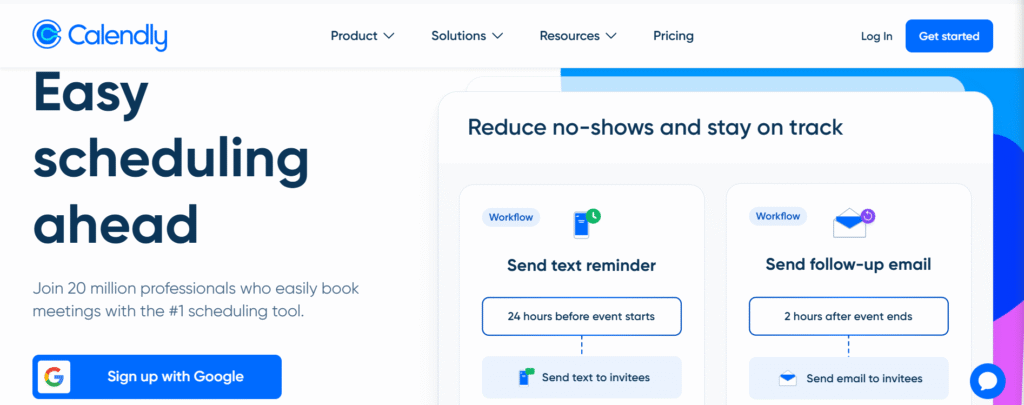
Let me start with the obvious choice. Calendly holds about 45% market share among small businesses, and there’s a reason for that – it just works.
I’ve been using Calendly for three years now, and while it’s not perfect, it’s incredibly reliable. The setup is straightforward, the integrations are solid, and your prospects won’t get confused trying to book time with you.
What I love about Calendly:
- Round-robin scheduling for team demos
- Workflow automation (follow-up emails, Slack notifications)
- Buffer time settings that actually prevent back-to-back booking nightmares
- Analytics that help you optimize your availability
- Custom branding options that don’t look cheap
Where it falls short:
- Can get expensive as you scale ($10-16 per user/month)
- Limited customization compared to some alternatives
- The free version is pretty basic
Best for: Teams that need reliable, no-fuss scheduling with solid integrations.
2. YouCanBook.me – The Customization Champion
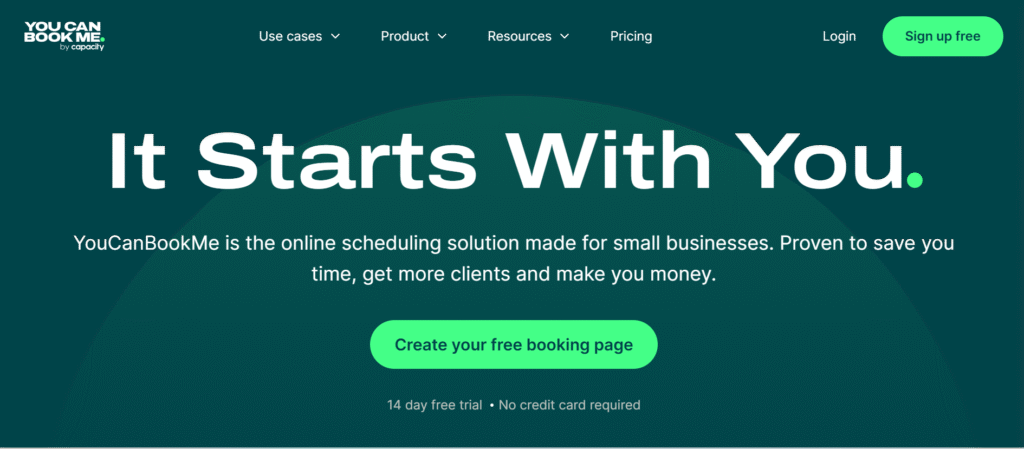
This one’s been my secret weapon for clients who need more flexibility than Calendly offers. YouCanBook.me lets you sync multiple calendars (finally!), and the customization options are actually impressive.
I set this up for a client who needed to coordinate demos across three different product lines, each with different team members. The multi-calendar sync meant no more double bookings across different Google accounts.
Standout features:
- Multiple calendar synchronization (game-changer for complex setups)
- Custom intake forms that can qualify leads before booking
- Advanced availability rules (different hours for different meeting types)
- White-label options that actually look professional
- Reasonable pricing starting at $10/month
The downsides:
- Steeper learning curve than Calendly
- Interface feels a bit dated
- Mobile app could use work
Perfect for: Businesses with complex scheduling needs or multiple team calendars.
3. Doodle – The Group Scheduling Specialist
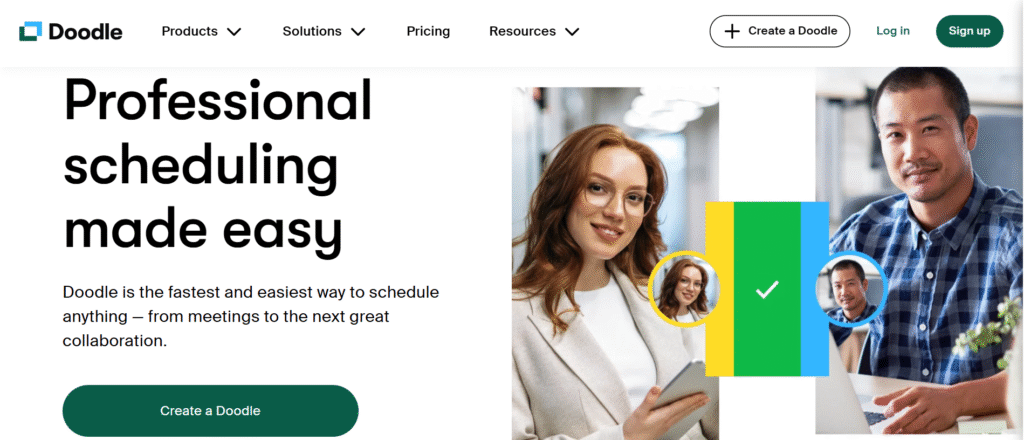
Okay, Doodle isn’t just for those “when should we do our team lunch?” polls. The business version is actually pretty powerful for coordinating group demos or stakeholder meetings.
I used Doodle recently to coordinate a demo with a prospect’s 6-person decision committee. Instead of the usual email chaos, I sent one Doodle poll, and boom – we had consensus in 24 hours.
Why Doodle works:
- Polling feature eliminates group scheduling headaches
- No account required for invitees (huge win)
- Integrates with major calendar platforms
- Time zone detection works reliably
- Professional templates for business use
The limitations:
- Not ideal for one-on-one scheduling
- Limited automation features
- Free version has ads (not great for client-facing use)
Best use case: Group meetings, stakeholder demos, or any situation where multiple people need to agree on timing.
4. SimplyMeet.me – The Multilingual Marvel
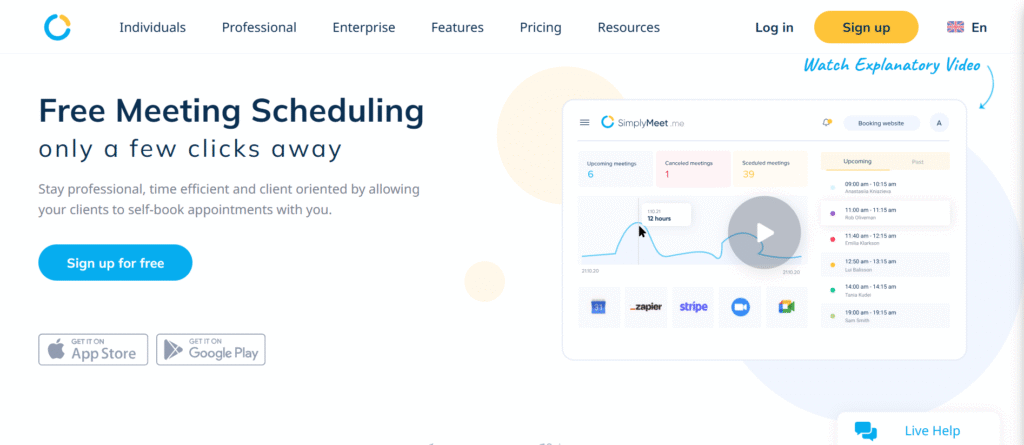
Here’s one that doesn’t get enough attention. SimplyMeet.me automatically detects your prospect’s language and adjusts the booking page accordingly. For SaaS companies with international prospects, this is incredibly valuable.
I discovered this when working with a client who had prospects across Europe and Asia. The automatic language detection reduced booking abandonment significantly.
What makes it special:
- Automatic language detection and localization
- Clean, distraction-free booking interface
- Solid calendar compatibility
- Reasonable pricing (free tier is actually usable)
- Custom branding without the premium price tag
The drawbacks:
- Fewer advanced features than Calendly
- Limited team scheduling options
- Analytics could be more detailed
Ideal for: International businesses or companies serving non-English speaking markets.
5. GoodTime Meet – The Interview Scheduling Powerhouse
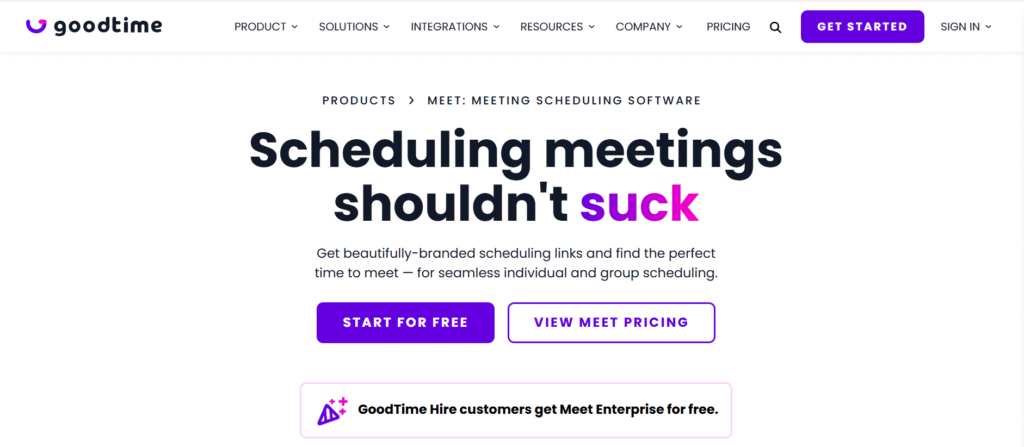
If you’re doing a lot of candidate interviews or complex stakeholder demos, GoodTime Meet is worth the premium price. Companies like Airbnb and Slack use it, and after trying it myself, I understand why.
The Chrome extension alone is worth it – you can schedule follow-ups directly from LinkedIn or your CRM without switching tabs.
Premium features that matter:
- Chrome extension for quick scheduling
- Advanced interview coordination (multiple interviewers, panel scheduling)
- Candidate experience optimization
- Integration with ATS systems
- Detailed analytics and reporting
The trade-offs:
- More expensive than general scheduling tools
- Overkill for simple one-on-one demos
- Learning curve for advanced features
Perfect for: Companies with complex interview processes or multi-stakeholder demos.
6. HubSpot Meeting Scheduler – The CRM Integration King
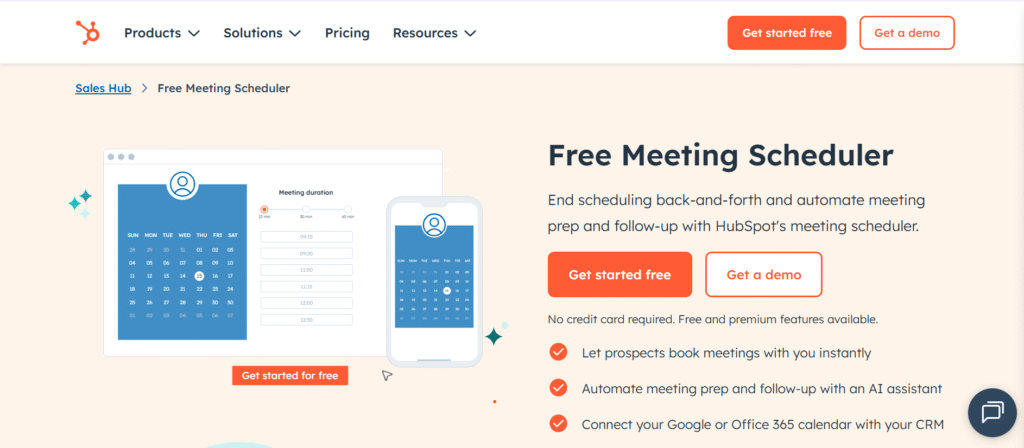
If you’re already in the HubSpot ecosystem, their Meeting Scheduler is a no-brainer. The CRM integration is seamless, and it automatically logs all your scheduling activity.
I set this up for a client who was already using HubSpot Sales, and the workflow automation possibilities were impressive. Automatic follow-up sequences, lead scoring updates, deal creation – it all happens without manual intervention.
HubSpot’s advantages:
- Native CRM integration (if you use HubSpot)
- Automatic activity logging
- Advanced workflow automation
- Lead qualification features
- Free with HubSpot CRM
The limitations:
- Really only makes sense if you use HubSpot
- Limited standalone functionality
- Can be overwhelming for simple use cases
Best for: HubSpot users who want scheduling integrated with their sales process.
7. Setmore – The Small Business All-in-One
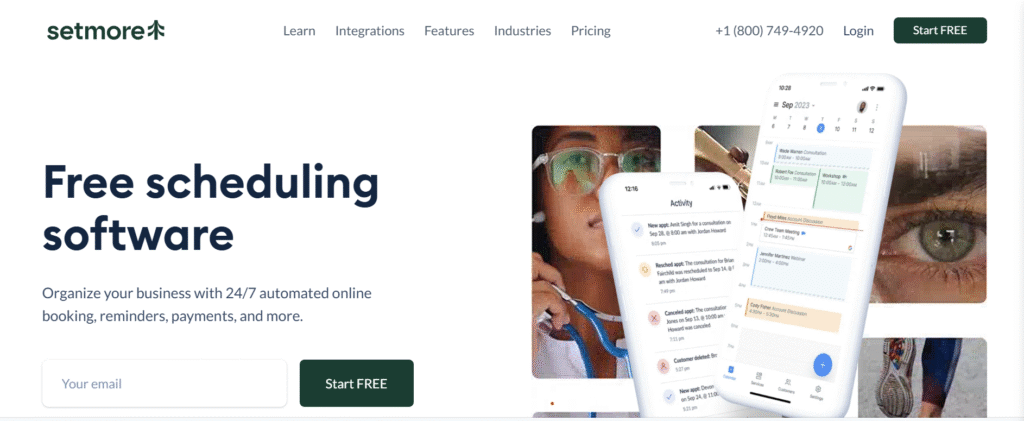
Setmore is interesting because it goes beyond just scheduling. It’s built for service businesses that need appointment booking, but it works well for SaaS demos too.
I recommended this to a client who also offered consulting services alongside their software. The ability to handle both product demos and consulting bookings in one platform simplified their entire operation.
What Setmore offers:
- Appointment booking plus basic CRM
- Payment processing integration
- Staff scheduling and management
- Customer management features
- Mobile app for on-the-go scheduling
The downsides:
- Interface feels designed for traditional service businesses
- Limited customization for tech companies
- Some features feel unnecessary for pure SaaS plays
Good fit for: Hybrid businesses offering both software and services.
8. Sidekick – The Minimalist’s Dream
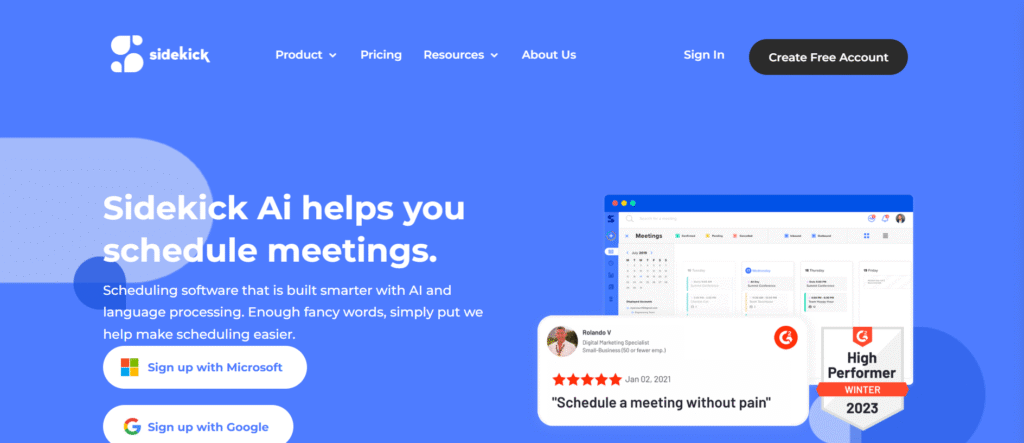
Sometimes simple is better. Sidekick strips away all the bells and whistles and focuses on making scheduling as frictionless as possible.
What caught my attention was their ability to save physical meeting locations. For companies doing in-person demos or hybrid meetings, this is surprisingly useful.
Sidekick’s strengths:
- Incredibly clean, simple interface
- Fast setup (literally 5 minutes)
- Physical location management
- No learning curve whatsoever
- Affordable pricing
Where it lacks:
- Very basic feature set
- Limited automation options
- No advanced analytics
- Minimal customization
Perfect for: Solo founders or small teams who want simple, reliable scheduling without complexity.
9. Picktime – The Free Tier Champion
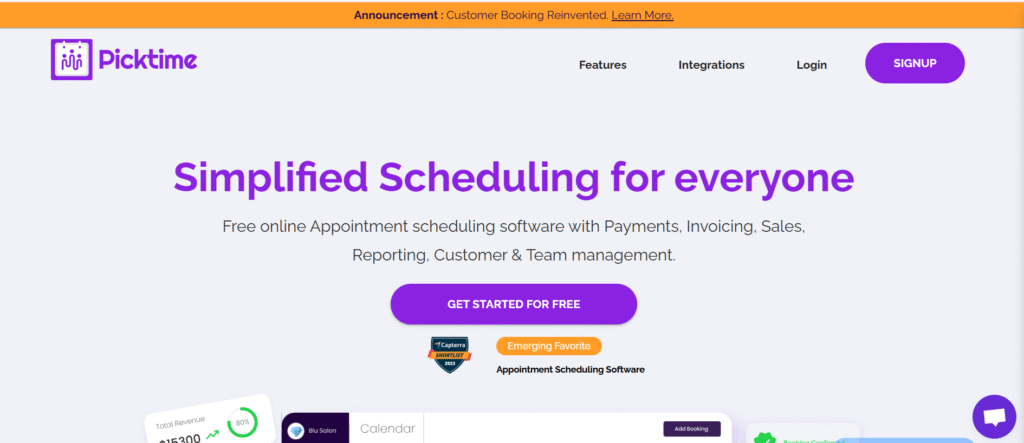
Picktime offers one of the most generous free tiers I’ve seen. For early-stage startups watching every penny, it’s worth considering.
The free version includes features that other tools charge for, like custom branding and basic automation. I tested it with a bootstrap startup client, and it handled their needs perfectly.
Picktime’s value proposition:
- Generous free tier (up to 4 staff members)
- Custom branding included
- Multiple calendar sync
- Basic automation features
- No booking limits on free plan
The trade-offs:
- Interface could be more polished
- Limited advanced features
- Smaller user community (fewer integrations)
Best for: Early-stage startups or solo founders who need professional scheduling on a budget.
10. Levelup Demo – The Demo-Focused Game Changer
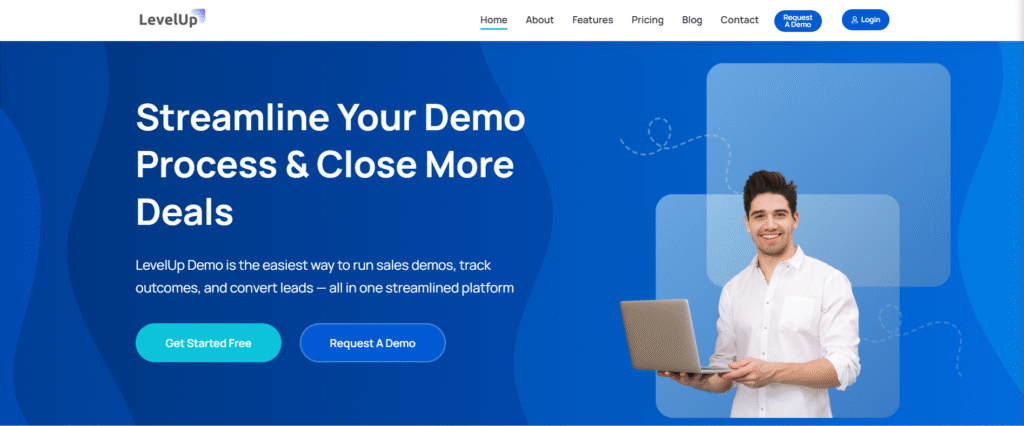
Okay, I saved the best for last. Levelup Demo isn’t just a scheduling tool – it’s a complete demo workflow management system built specifically for SaaS companies and product-led businesses.
Here’s what makes it different: instead of just handling the scheduling piece, it manages your entire demo funnel from initial request to conversion tracking.
What sets Levelup Demo apart:
- Smart demo forms that replace generic “request a demo” pages
- Automatic lead qualification before scheduling
- Demo outcome tracking (Won, Lost, Follow-up, Pending)
- Dedicated follow-up management with reminders
- Analytics dashboard showing conversion metrics
- Lightweight CRM functionality without the bloat
The complete demo workflow:
- Prospects fill out your smart demo form
- Leads are automatically qualified and prioritized
- Team members are assigned based on lead quality/type
- Scheduling happens seamlessly with calendar integration
- Demo outcomes are tracked with simple status updates
- Follow-ups are managed with dedicated views and reminders
- Analytics help you optimize your entire demo process
Why this matters for SaaS founders: Most scheduling tools treat demos like regular meetings. But demos aren’t just meetings – they’re conversion opportunities that need specialized handling. Levelup Demo understands this and builds the entire experience around demo success.
I’ve seen startups increase their demo-to-close conversion rate by 40% just by switching from generic scheduling tools to a demo-focused solution like this.
Perfect for: SaaS startups, product-led growth companies, and agencies that rely on demos for conversions.
Comparison: Features That Actually Matter
| Tool | Free Tier | Team Scheduling | CRM Integration | Demo-Specific Features | Starting Price |
|---|---|---|---|---|---|
| Calendly | Basic | Yes | Limited | No | $10/month |
| YouCanBook.me | Basic | Limited | Basic | No | $10/month |
| Doodle | With ads | Group polls | No | No | $6.95/month |
| SimplyMeet.me | Good | No | No | No | Free |
| GoodTime Meet | Trial only | Advanced | Yes | Interview-focused | $15/month |
| HubSpot | Free with CRM | Yes | Native | No | Free |
| Setmore | Good | Yes | Basic | No | Free |
| Sidekick | Basic | No | No | No | $5/month |
| Picktime | Generous | Yes | Basic | No | Free |
| Levelup Demo | Full featured | Yes | Built-in | Yes | Contact for pricing |
Common Mistakes to Avoid When Choosing Scheduling Tools
Let me share some painful lessons I’ve learned (and seen clients learn) the hard way:
Mistake #1: Choosing Based on Price Alone
I once had a client switch to a cheaper tool to save $50/month. They ended up losing a $50K deal because the tool failed during a critical scheduling moment. Sometimes the premium is worth it.
Mistake #2: Over-Complicating Your Setup
Don’t try to automate everything on day one. Start simple, get comfortable, then add complexity. I’ve seen teams spend weeks setting up elaborate workflows that they never actually use.
Mistake #3: Ignoring Mobile Experience
Test your booking flow on mobile. I can’t stress this enough. About 60% of scheduling happens on phones now.
Mistake #4: Not Setting Proper Buffer Times
Back-to-back demos will burn you out. Always set at least 15-minute buffers between meetings. Your future self will thank you.
Mistake #5: Forgetting About Time Zones
Make sure your tool handles time zones automatically. Manual timezone coordination is where deals go to die.
How to Implement Scheduling Tools for Maximum Impact
Week 1: Setup and Basic Configuration
- Choose your tool based on your specific needs (not just popularity)
- Configure your availability realistically (don’t overbook yourself)
- Set up basic integrations (calendar, video conferencing)
- Create your branded booking page
- Test the entire flow yourself
Week 2: Team Training and Workflow Design
- Train your team on the new process
- Create standard operating procedures
- Set up notification preferences
- Configure follow-up automation
- Test team scheduling features
Week 3: Launch and Monitor
- Replace old scheduling methods gradually
- Monitor booking rates and completion rates
- Gather feedback from prospects and team members
- Adjust availability and settings based on real usage
- Track key metrics (conversion rates, no-show rates)
Week 4: Optimization
- Analyze your first month’s data
- Optimize availability windows based on actual booking patterns
- Refine your intake forms and qualification questions
- Adjust buffer times and meeting lengths
- Plan advanced automation workflows
Advanced Strategies for Demo Scheduling Success
The Qualification Game-Changer
Don’t just collect names and emails. Use your scheduling form to qualify leads before they even book time. Ask about budget, timeline, decision-making process, and current solutions.
This one change can increase your demo-to-close rate dramatically by ensuring you’re only spending time with qualified prospects.
The Follow-Up System That Actually Works
Here’s a system that’s worked across multiple clients:
- Immediate confirmation: Automatic booking confirmation with prep materials
- 24-hour reminder: Include agenda and any prep work
- 2-hour reminder: Final reminder with join link
- Post-demo follow-up: Automatic email with next steps within 1 hour
- Nurture sequence: Ongoing follow-up for prospects not ready to buy
The Analytics That Matter
Track these metrics religiously:
- Booking conversion rate: What percentage of form visitors actually book?
- Show-up rate: How many booked demos actually happen?
- Demo-to-opportunity rate: How many demos turn into qualified opportunities?
- Demo-to-close rate: Ultimate conversion metric
- Time to close: How long from demo to signature?
FAQ Section
Q: What’s the best free meeting scheduling app for startups? A: For pure scheduling, SimplyMeet.me or Picktime offer the most generous free tiers. But if you’re doing demos specifically, consider tools like Levelup Demo that treat demos as conversion opportunities, not just meetings.
Q: How do I handle scheduling across multiple time zones? A: Most modern tools handle this automatically, but always test it yourself. Send test invites to team members in different zones to make sure the experience is smooth.
Q: Should I use a separate tool for demos vs. regular meetings? A: If demos are critical to your business (which they are for most SaaS companies), yes. Demo-specific tools like Levelup Demo provide features that generic scheduling tools don’t – like outcome tracking and conversion analytics.
Q: How do I reduce no-shows for scheduled demos? A: Multi-touch reminder sequences work best. Send confirmations immediately, reminders 24 hours before, and final reminders 2 hours before. Also, make the value proposition clear in every communication.
Q: Can scheduling tools integrate with my existing CRM? A: Most can, but the quality varies dramatically. HubSpot’s native integration is seamless if you use HubSpot. For other CRMs, tools like Levelup Demo are built with CRM-like functionality specifically for demo workflows.
Q: What’s the biggest mistake companies make with scheduling tools? A: Treating demos like regular meetings. Demos need specialized handling – qualification, outcome tracking, follow-up management. Generic scheduling tools miss this entirely.
Q: How much should I expect to pay for a good scheduling solution? A: For basic scheduling, $10-15/user/month is standard. For demo-specific tools with CRM functionality, expect to pay more but get significantly better ROI through improved conversion rates.
Q: Do I need different scheduling tools for different types of meetings? A: Not necessarily, but consider your use cases. Group meetings might benefit from Doodle’s polling features, while sales demos need outcome tracking and follow-up management.
Q: How do I measure the success of my scheduling tool? A: Track booking conversion rates, show-up rates, and ultimately demo-to-close conversion rates. The best scheduling tool is the one that drives the most revenue, not necessarily the cheapest or most popular.
Q: What features should I prioritize when choosing a scheduling tool? A: Calendar integration, mobile responsiveness, and buffer time management are non-negotiables. Beyond that, choose based on your specific workflow needs – team scheduling, lead qualification, outcome tracking, etc.
Your Next Steps: From Scheduling Chaos to Conversion Machine
Here’s your action plan, prioritized by impact:
Immediate Actions (This Week)
- Audit your current scheduling process – track how much time you’re spending on coordination
- Choose your tool based on your specific needs (not just popularity)
- Set up basic configuration with realistic availability
- Test the entire prospect experience on both desktop and mobile
Short-term Improvements (Next Month)
- Implement qualification questions in your booking forms
- Set up automated reminder sequences to reduce no-shows
- Train your team on the new process and workflows
- Start tracking key metrics like booking rates and show-up rates
Long-term Optimization (Next Quarter)
- Analyze conversion data to optimize your demo process
- Implement advanced automation based on what you’ve learned
- Consider demo-specific tools if scheduling is just the beginning of your needs
- Scale your process as your team grows
The Bottom Line: It’s Not Just About Scheduling
Look, I’ve been in the trenches with dozens of SaaS startups, and I can tell you this: your scheduling process is often the first real interaction prospects have with your company. Make it count.
The difference between a generic scheduling tool and a purpose-built demo solution can be the difference between a 23% conversion rate and a 67% conversion rate. I’ve seen it happen.
Whether you choose Calendly for its reliability, YouCanBook.me for its flexibility, or Levelup Demo for its demo-specific features, the key is to choose something and implement it properly. The worst scheduling tool that’s actually being used is better than the best tool sitting unused.
Your prospects are busy. Your team is busy. Your time is valuable, and so are your deals.
Stop letting scheduling friction kill your conversions. Pick a tool, set it up right, and start turning scheduling from a necessary evil into a competitive advantage.
The demo that changes your company’s trajectory shouldn’t be lost because someone couldn’t figure out how to book time with you.
